Florida is a paradise for not only retirees and vacationers but also bird enthusiasts, with its diverse ecosystems offering habitat to a plethora of unique and colorful birds. The state's subtropical climate and vast wetlands provide a haven for both migratory and resident bird species, making it an ideal destination for bird watching year-round.
From the vibrant pink Roseate Spoonbills to the stunning purple gallinule, Florida is home to some of the most spectacular and rare bird species in the world. In this article, we will explore some of the most distinctive birds that can be found in Florida, highlighting their unique characteristics and habitats.
1. Roseate Spoonbill
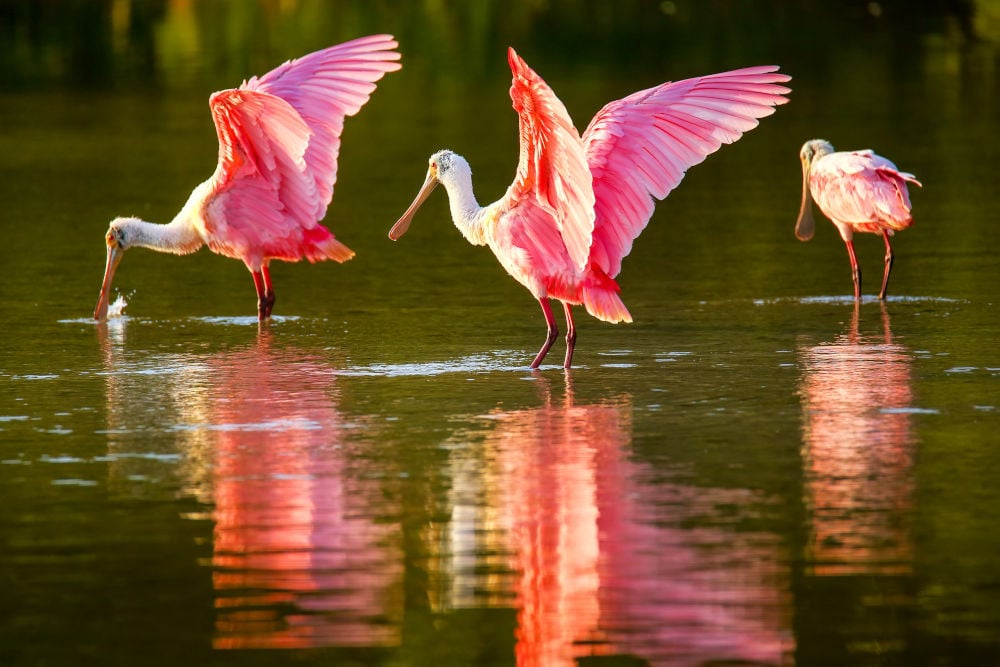
The Roseate Spoonbill is a bird species found in the Americas, from the southeastern United States through Central America and down to South America. They are medium to large-sized birds, with a wingspan of up to 4 feet and a height of around 31 inches.
They are easily identifiable by their unique spoon-shaped bill, which they use to filter feed in shallow water. The Roseate Spoonbill's plumage is a bright pink or reddish color, with white feathers on their neck and back.
They have long, thin legs that are black in color, and their eyes are a bright red. They are social birds and often seen in groups, particularly during breeding season when they gather in large colonies to build nests and raise their young.
Roseate Spoonbills feed by sweeping their bill back and forth through shallow water to catch small fish, crustaceans, and insects. They can often be seen wading in shallow water, sometimes even standing on one leg while they hunt for food. Their bills contain sensitive nerve endings that help them detect prey in the murky water.
The Roseate Spoonbill's breeding season varies depending on their location, but typically occurs between January and August. During this time, males perform elaborate courtship displays to attract females, including ritualized displays of their colorful plumage and elaborate dances.
Both males and females contribute to nest building, which typically takes place in trees or shrubs near water. Females lay 2-4 eggs, which hatch after around 3 weeks. Both parents take turns incubating the eggs and caring for the chicks until they fledge after around 6-7 weeks.
Roseate Spoonbills primarily feed on small fish, crustaceans, and aquatic invertebrates. Their unique spoon-shaped bill is well adapted for filter feeding, which involves sweeping their bill back and forth through shallow water to capture prey. The bill contains sensitive nerve endings that help them detect prey in the muddy or murky water.
They may also consume small amphibians, reptiles, and insects, and occasionally they feed on plant material. Their diet can vary depending on the availability of prey in their habitat and can be influenced by factors such as season and weather conditions. They are opportunistic feeders and will adjust their feeding behavior to take advantage of available food sources.
2. Wood Stork

The wood stork is a large wading bird found in the Americas, ranging from the southeastern United States to Argentina. It is the only species of stork that breeds in North America.
Wood storks have a distinctive appearance with a bald, dark gray head and long, thick down-curved bill. They have white plumage with black flight feathers and a black tail. Adults can grow up to 3.5 feet in height and have a wingspan of around 5.5 feet.
They typically inhabit wetlands, such as marshes, swamps, and ponds, where they feed on fish, crustaceans, and other aquatic creatures. Wood storks are known for their unique feeding behavior, which involves using their sensitive bills to feel for prey in the murky water.
The wood stork is listed as a federally endangered species in the United States, with populations declining due to habitat loss, disturbance, and changes in water management practices. Conservation efforts, including habitat restoration and protection, have helped stabilize populations in some areas.
Wood storks typically make their nests in trees that are standing in or near water. They prefer trees such as cypress, maple, or red bay that have a broad canopy and provide good protection from the sun and rain. The nests are usually located in a colony, with multiple nests in the same tree or adjacent trees.
The male wood stork brings sticks and branches to the nest site, and both the male and female use their bills to shape the nest into a shallow platform. They line the nest with leaves, moss, and other soft materials. The nests can be up to 4 feet in diameter and can be used for several breeding seasons.
Wood storks are colonial breeders, which means they often nest in large groups. These nesting colonies are known as rookeries, and they can contain hundreds or even thousands of nests. The colonies provide safety in numbers and help the storks find suitable nesting sites.
3. Purple Gallinule
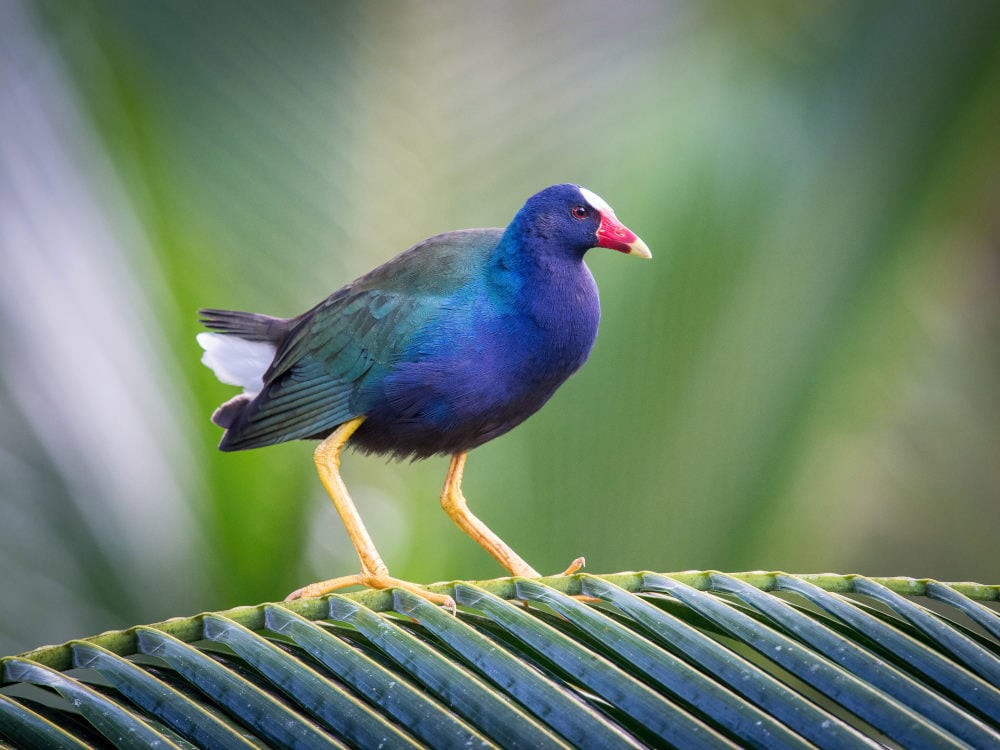
The Purple Gallinule is a colorful bird species that belongs to the rail family, Rallidae. They are found in freshwater marshes, swamps, and other wetland habitats in the southeastern United States, Mexico, Central America, the Caribbean, and South America.
The Purple Gallinule is a medium-sized bird, measuring around 10-15 inches in length and weighing between 4-7 ounces. The bird has bright, iridescent plumage, with a blue and green head, purple-blue breast, and greenish-yellow belly. Its beak is red and its legs and feet are bright yellow.
Purple Gallinules are known for their ability to walk on floating vegetation and swim in open water. They are omnivores and feed on a variety of plant and animal matter, including seeds, fruits, insects, snails, and small fish.
The Purple Gallinule is a vocal bird, and its calls are a series of high-pitched, whistled notes. During breeding season, males and females engage in courtship displays that involve calling, preening, and offering food to one another.
Purple Gallinules are monogamous and breed throughout the year, depending on the availability of food and water. They build their nests in dense vegetation, and females lay between 4-10 eggs per clutch. Both parents take turns incubating the eggs and caring for the chicks.
4. Great Blue Heron
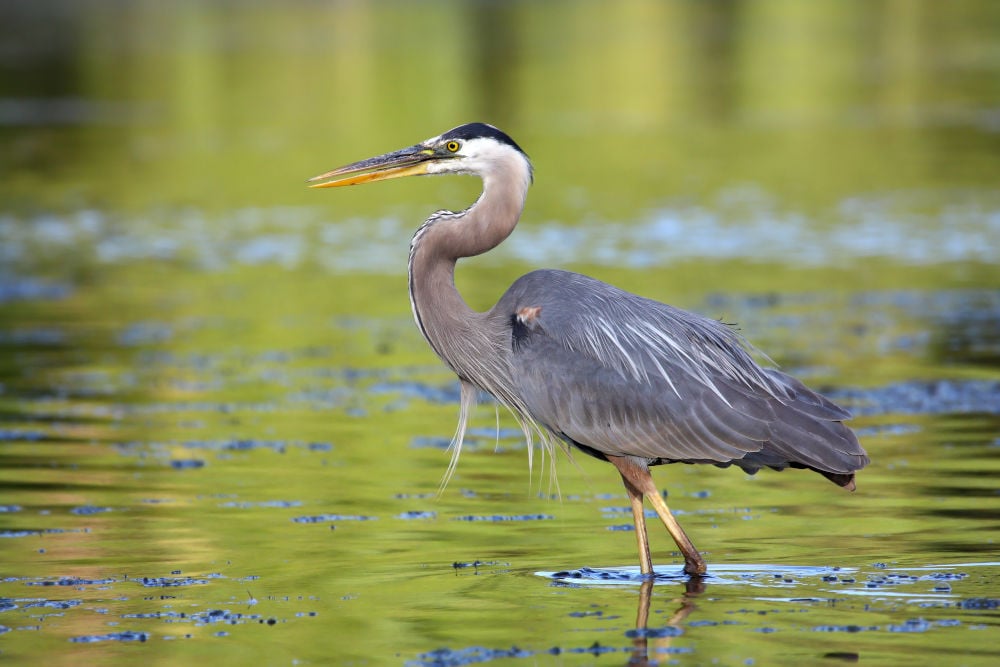
The Great Blue Heron is a large wading bird with distinctive blue-gray plumage, a long neck, and a sharp, pointed bill. It can be found throughout North America in a variety of wetland habitats, such as marshes, swamps, and riverbanks. It is also known to inhabit shallow coastal waters and other open areas near water.
This carnivorous bird feeds mainly on fish, but will also eat frogs, snakes, insects, and other small animals. It hunts by standing still in shallow water and waiting for its prey to come within striking distance.
Great Blue Herons are solitary birds that spend much of their time wading through shallow water in search of food. They are also skilled hunters and can stand motionless for long periods of time as they wait for their prey.
They are monogamous and usually mate for life, building large nests in trees near water and laying 2-6 eggs per clutch. Both parents take turns incubating the eggs and feeding the chicks until they fledge and leave the nest.
While the Great Blue Heron is currently listed as a species of "Least Concern," habitat loss and degradation, pollution, and other human activities can still pose a threat to its population. Nonetheless, it remains an important and admired bird species in North America, recognized for its beauty, grace, and role in maintaining healthy wetland ecosystems.
5. Snowy Egret
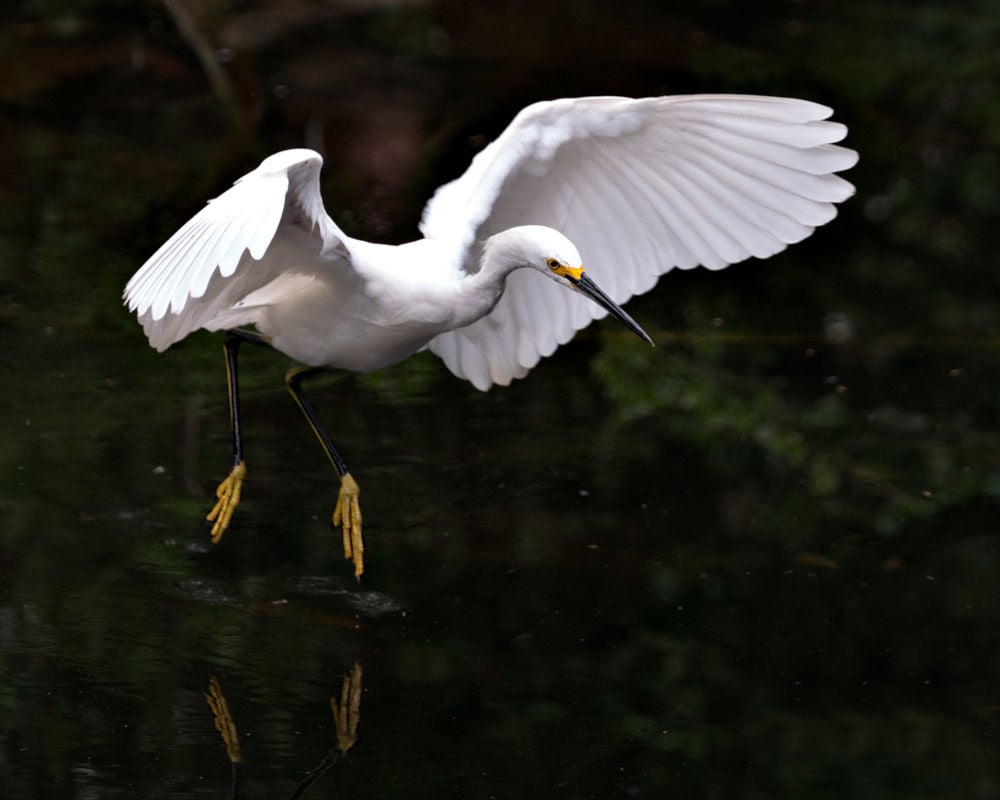
The snowy egret is a species of small heron that is native to North, Central, and South America. It is a member of the egret family, which also includes other species like the great egret, little egret, and cattle egret. The snowy egret is a relatively small bird, with a body length of around 22 inches and a wingspan of about 38 inches.
It is known for its slender build, with long legs, a long neck, and a straight, pointed bill. The snowy egret is most easily recognized by its striking white plumage, which covers most of its body, including its wings and tail. It also has distinctive yellow feet and a black bill.
Snowy egrets are found in a variety of wetland habitats, including marshes, swamps, and estuaries. They are highly adaptable birds and can also be found in other habitats, such as tidal flats, mudflats, and even on beaches.
They are also known to inhabit urban areas like parks and golf courses.
vSnowy egrets are primarily carnivorous and feed on a variety of small aquatic animals, including fish, amphibians, crustaceans, and insects. They are known for their unique feeding behavior, where they use their bright yellow feet to stir up the water and flush out their prey. They then strike quickly with their bill to capture their prey.The snowy egret was heavily hunted in the 19th and early 20th centuries for its beautiful feathers, which were used in the millinery trade to make hats. This led to a severe decline in its population, and the species was nearly extinct in some areas. Today, the snowy egret is protected by law, and its population has recovered significantly. It is still considered a species of concern in some areas due to habitat loss and other threats.
6. Reddish Egret
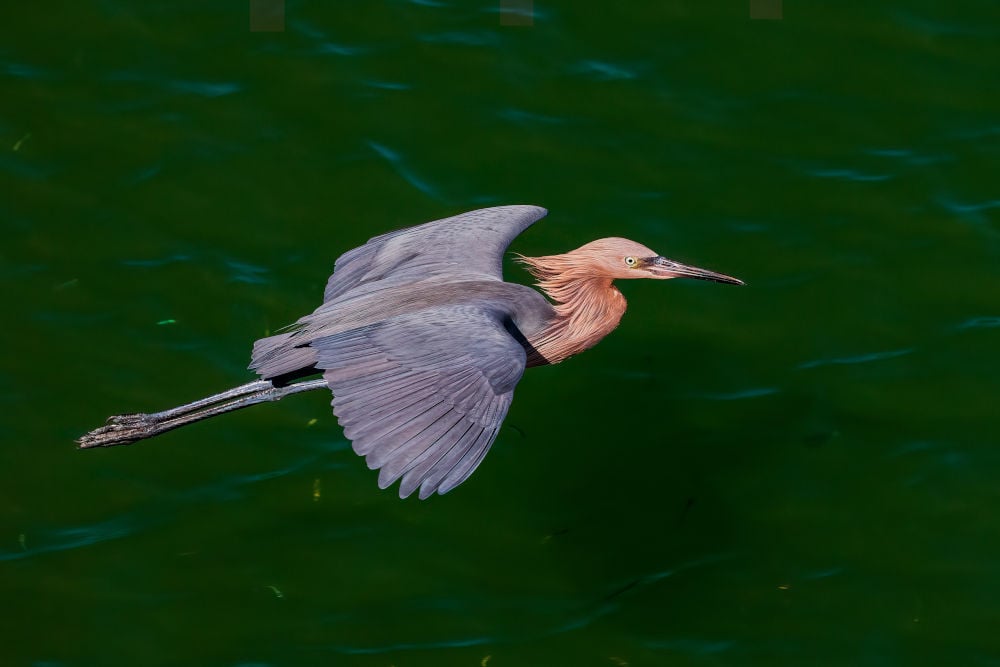
The Reddish Egret is a medium-sized heron that is found along the coastlines and in the wetlands of the Gulf of Mexico and the southern Atlantic coast of the United States.
Reddish Egrets have a distinctive appearance, with a shaggy appearance due to the long, wispy feathers on their necks, backs, and heads. They have a reddish-brown body with a blue-gray head and neck. Their legs are long and thin, and they have a long, pointed bill that is used to catch prey.
Reddish Egrets are known for their unique hunting behavior. They are one of the few species of birds that use their wings to create shade in the water while hunting. This creates a shadow that attracts fish, which the egret then captures with its bill. They are also known for their aggressive foraging behavior, running and spinning in circles to stir up fish and other prey from the shallow waters.
Reddish Egrets also have a unique mating routine. They are known for their courtship displays which involve a series of elaborate dance-like movements, including running, jumping, and flapping their wings.
As mentioned, they are primarily found in coastal wetlands, salt marshes, and mangrove swamps, but can also be found in freshwater marshes and ponds. Reddish Egrets are important indicators of the health of coastal wetlands and estuaries, as they are sensitive to changes in water quality and habitat degradation. Their decline or disappearance from an area can signal problems with the ecosystem.
Reddish Egrets are considered a species of concern due to habitat loss and disturbance, and their populations have declined in some areas. They are protected under the Migratory Bird Treaty Act and other laws. Conservation efforts, such as habitat restoration and protection, have been implemented to help protect this unique and important species.
7. Painted Bunting
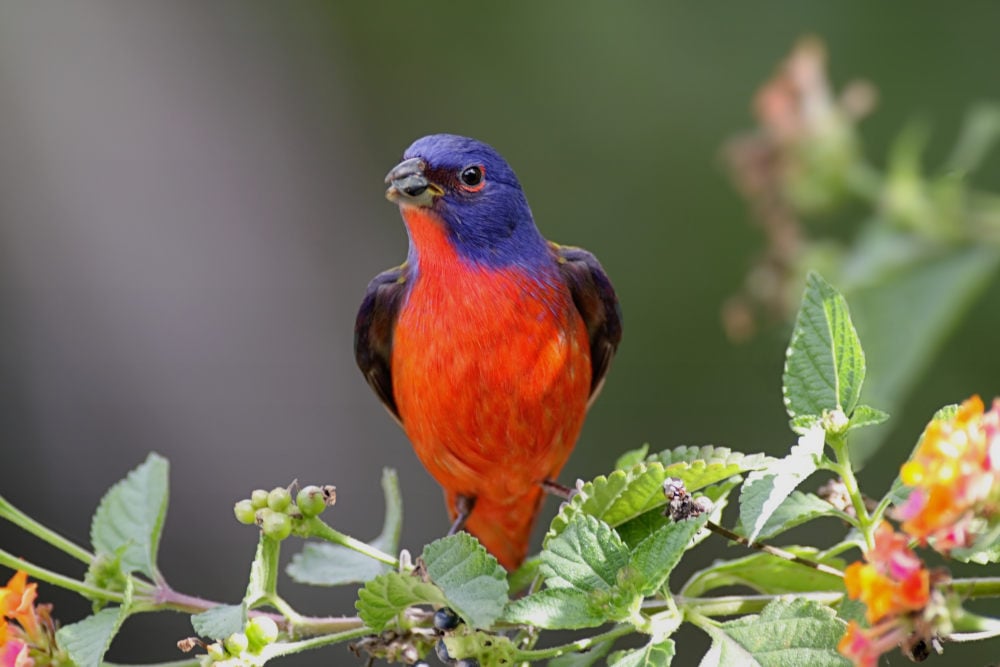
The painted bunting is a small, brightly colored songbird that is native to North America. It is known for its vibrant plumage, with males sporting a striking combination of blue, green, and red feathers, while females are a more subdued greenish-yellow color.
Painted buntings can be found in a variety of habitats, including shrubby areas, forests, and fields, primarily in the southern United States and Mexico. They are known for their beautiful songs, which are often heard during the breeding season.
During breeding season, male painted buntings establish territories and perform courtship displays to attract females. They will sing from perches, puff up their feathers, and show off their colorful plumage in an attempt to impress potential mates.
The painted bunting's song is a series of clear, high-pitched notes, which are often described as sounding like a series of metallic pings or chimes. The song is relatively short and consists of 2-4 notes, which are repeated several times in a row. The exact pattern of the song can vary between individuals, but it is generally a simple and distinctive series of notes.
Male painted buntings are known for their complex and varied vocalizations, which include a range of songs and calls. They are considered one of the most melodious songbirds in North America. Female painted buntings also sing, but their songs are less complex and generally used for communication within a mating pair.
Painted buntings primarily feed on seeds, but they will also eat insects and fruits. They are often seen at bird feeders, where they will feed on millet and other seeds.
Despite their beauty and popularity among birdwatchers, painted buntings face a number of threats, including habitat loss and fragmentation, as well as capture for the pet trade. Conservation efforts are underway to protect their habitats and raise awareness about their plight.
8. Greater Flamingo

The greater flamingo is a large, pink bird with long legs and neck, belonging to the family Phoenicopteridae. They can be found in parts of Africa, southern Europe, and southern Asia, primarily in shallow, saline or alkaline wetlands such as salt pans, lagoons, and estuaries.
They are also found in man-made habitats such as sewage treatment ponds and fish ponds. The greater flamingo is the largest species of flamingo, standing at 3.5 to 5 feet tall and weighing 4.4 to 8.8 pounds. They have long, thin legs with webbed feet that help them walk in muddy areas, and their wingspan can reach up to 55 inches.
Their pink coloration comes from pigments in the algae and crustaceans they eat. freater flamingos are filter feeders, using their specialized beaks to filter out tiny organisms such as brine shrimp and blue-green algae from the water. They also feed on insects, small fish, and mollusks.
Their beaks are adapted to this unique feeding behavior, with a comb-like structure that allows them to sift through the water. Greater Flamingos are highly social birds and are often found in large flocks that can number in the thousands. They engage in elaborate courtship displays, including synchronized dancing and wing-spreading, to attract mates. During breeding season, they build nests out of mud and lay a single egg, which both parents incubate.
9. Cinnamon Teal
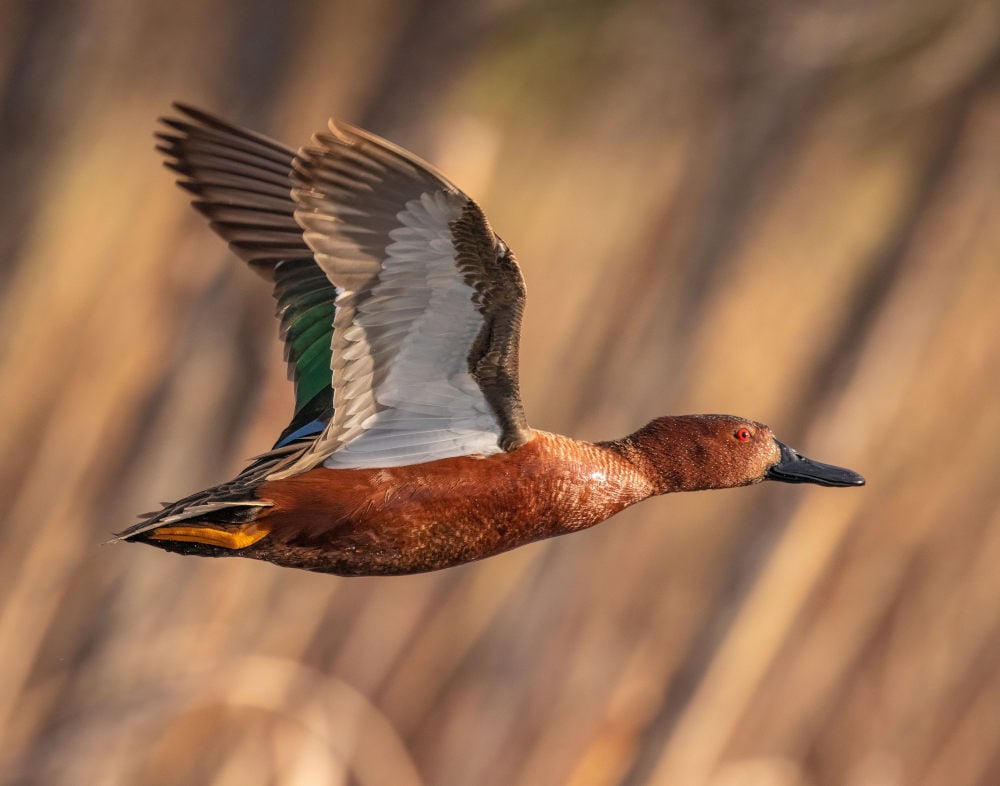
The Cinnamon Teal is a species of dabbling duck that belongs to the genus Spatula, which includes other ducks such as the Mallard and the Blue-winged Teal. The scientific name of the Cinnamon Teal is spatula cyanoptera.
The male Cinnamon Teal has a striking cinnamon-colored head and body, with bright red eyes and a blue bill. The female has a mottled brown body and a grayish-brown head. Both sexes have blue-gray wings with a distinctive green speculum (a patch of feathers on the wing).
The Cinnamon Teal is a medium-sized duck, with males measuring about 16-18 inches in length and females measuring about 14-17 inches in length.
Cinnamon Teals are found in freshwater wetlands, marshes, and ponds in western North America, from Alaska and Canada down to Mexico. They are known for their distinctive vocalizations, which include a series of whistles and grunts.
Cinnamon Teals are omnivorous, feeding on a variety of plants and animals such as seeds, aquatic vegetation, insects, and crustaceans. They are also known for their unique foraging behavior, in which they spin in circles on the water's surface to stir up food from the bottom.
The breeding season for Cinnamon Teals typically occurs between April and August. During this time, males perform courtship displays to attract mates, including head-bobbing, wing-flashing, and vocalizations.
Cinnamon Teals typically nest in dense vegetation near the water's edge, building a shallow depression lined with down feathers. Females lay an average of 8-10 eggs per clutch, which they incubate for about 24-26 days.
After hatching, Cinnamon Teal ducklings are able to leave the nest and swim within a day or two. They are precocial, meaning they are born with down feathers and are able to walk and feed themselves shortly after hatching.
10. American Wigeon
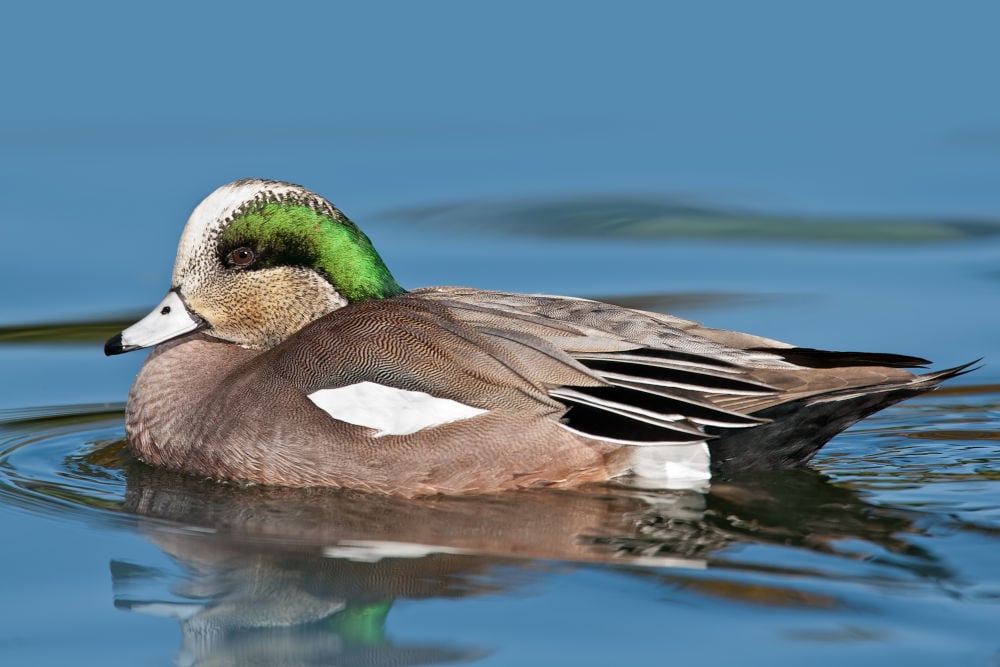
The American Wigeon is a medium-sized dabbling duck found throughout North America. It is also known as the Baldpate due to its distinctive white crown.
Male American Wigeons have a distinctive breeding plumage, which includes a rusty-colored head and neck, a white crown, and a grayish-blue bill. Their bodies are mostly gray with white undersides and black-and-white striped wings.
In non-breeding plumage, males look similar to females, with a gray-brown head and neck, and a light gray body. Female American Wigeons have a gray-brown body with a pale brown head and a dark brown eye patch. They also have a white belly and a blue-gray bill.
American Wigeons typically feed on aquatic vegetation, insects, and small invertebrates. They can often be seen foraging in shallow water or on land near water sources.
During breeding season, American Wigeons form pairs and breed in wetlands, marshes, and other shallow water habitats. Females typically build nests on the ground, concealed in vegetation. Clutches usually consist of 6-12 eggs, which hatch after an incubation period of about 25 days.
American Wigeons are migratory birds and can be found throughout North America during the winter months. They typically migrate to the southern United States, Mexico, and Central America.
Conclusion
In conclusion, Florida is home to a diverse array of unique bird species that can be found nowhere else in the world. From the iconic pink flamingo to the elusive scrub jay, each bird brings its own beauty and charm to the state.
The natural habitats and ecosystems of Florida provide these birds with a perfect environment to thrive and flourish. However, it is incredibly important to remember that these birds are not just beautiful to observe, but they also play a vital role in maintaining the delicate balance of the state's ecosystem. As such, it is important to preserve and protect these birds and their habitats for future generations to enjoy.
FAQ
What birds are native to Florida?
Florida is home to a diverse range of bird species, including both year-round residents and migratory birds that visit during the winter months. Some of the most common native bird species found in Florida include:
American Flamingo, Bald Eagle, Brown Pelican, Double-crested Cormorant, Great Blue Heron, Limpkin, Osprey, Roseate Spoonbill, Sandhill Crane, Snowy Egret, Tricolored Heron, White Ibis, Wood Stork
What makes birds unique?
Birds are a unique class of animals that have several distinguishing features that set them apart from other animals: Feathers: Feathers are a unique and defining characteristic of birds. They provide insulation, help with flight, and are used for display and communication. Wings: Birds are the only animals with wings that are designed specifically for flight. While some other animals, such as bats, can also fly, their wings are made from different materials and have a different structure. Beaks: Birds have beaks instead of teeth, which they use for a variety of tasks, including eating, grooming, and defense. Lightweight Skeleton: Birds have a lightweight skeleton that is designed to help them fly. Their bones are hollow, and many of them are fused together to provide strength and stability. Efficient Respiratory System: Birds have a unique respiratory system that allows them to get the oxygen they need to fly at high altitudes. They have air sacs in addition to lungs, which allows them to get a continuous flow of fresh air. Unique Vocalizations: Birds are known for their unique vocalizations, which they use for communication and attracting mates.
Is it illegal to feed birds in florida?
In Florida, feeding birds is generally not illegal, but it can be regulated by local ordinances or state laws. Some cities or counties may have specific laws or regulations related to feeding wild animals, including birds, in public spaces or in residential areas. These laws may be in place to protect public health, reduce wildlife conflicts, or prevent the spread of diseases.
Why birds flock?
Birds flock for a variety of reasons, including safety, social interaction, and foraging efficiency. Here are some of the main reasons why birds flock: Safety: By flying in large groups, birds can reduce their chances of being caught by predators. Flocking birds also have a better chance of spotting predators and can alert each other to danger. Social Interaction: Flocking allows birds to interact with each other and establish social hierarchies. Some bird species also use flocking behavior as part of their mating rituals. Foraging Efficiency: Birds can more efficiently find food by foraging in large groups. Flocking birds can cover a larger area and can signal to each other when they find a food source. Migration: Some bird species migrate in large flocks to their breeding or wintering grounds. Flocking allows birds to conserve energy by taking advantage of wind currents and by following other birds.






